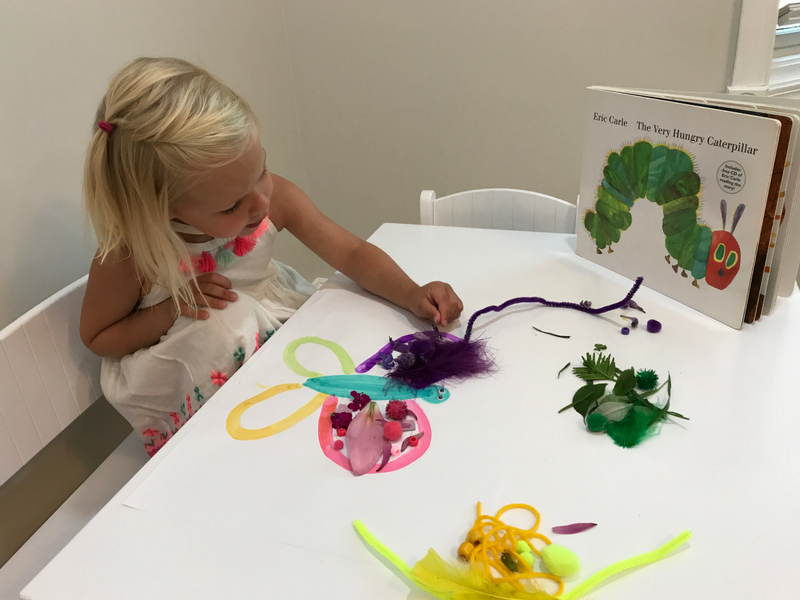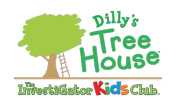
06 Jul Learning with Literature: The Very Hungry Caterpillar
After all these years and countless new children’s book authors, no books steal the spotlight quite like Eric Carle books. The bright colors, intricate patterns, clever construction, and cheerful disposition of his books radiate from the bookshelf and draw in readers of all ages. If you don’t have the book already, you’ll want to pick up a copy of Eric Carle’s The Very Hungry Caterpillar to experience the magic for yourself. But story time is only where the magic begins. This story is rich with opportunities to extend learning, particularly in the areas of STEAM—Science, Technology, Engineering, Art, and Math. Here are a few activities to keep the Eric Carle magic alive while developing STEAM skills with your child.
The Very Hungry Caterpillar –Activities to Develop STEAM Skills
Science
Pasta Life Cycle: Use pasta shapes to teach your child about the butterfly life cycle. Rotini pasta represents the caterpillar stage, shell pasta represents the cocoon stage, and bowtie pasta represents the butterfly stage. Have your child put the shapes in order to represent the life cycle of the butterfly. When she tires of the activity, you can cook the pasta together and eat it just like the very hungry caterpillar!
See It Yourself: You can bring the book to life for you and your child by ordering a kit that will allow you to witness the transformation from caterpillars to butterflies in as little as 3 weeks. The kit includes all the supplies needed to raise and care for caterpillars and adult butterflies. Visit the Carolina website for more information or to purchase a kit.
Technology
Search Is On: Model how to use search engines, so your child sees the internet as a source of information as much as entertainment. Challenge yourself to learn more about the butterfly life cycle. Search for one image or diagram, one video, and one text selection that gives you the information you are looking for.
Slideshow: Start early showing your child that technology is not just something we consume, but it is something that can help us create. Find images of butterflies and create a photo slideshow using tools such as PhotoPeach.com or Animoto.com. Both of these sites are free, easy to use, and can deliver a delightful slideshow set to music within the attention span of your child.
Engineering
Stacked Caterpillar: Challenge your child to build a vertical caterpillar. Use bottle caps, buttons, checkers, or some other small circular material. You may want to glue google eyes and/or chenille sticks (for antenna) on some of the circles as a head. Measure the caterpillar after each addition to see how high it can grow before it topples over. Try it with different materials to see how the materials effect the height of the caterpillar.
Build a Book: Recreate your own version of the story by building your own book. Instead of providing materials, challenge your child to figure out what materials she might need to create the book. She may just fold paper, or she may surprise you with more sophisticated construction ideas. Let her lead the way!
Art
Tissue Paper Patterns: Cut colored tissue paper into different shapes. Have your child glue the tissue paper onto a background paper to recreate images from the book. For example, if you cut out circles in different colors of green tissue paper, your child can glue them together, overlapping slightly, to form the body of the caterpillar.
Mixed Media Butterfly Collage: Collect different kinds of materials (beads, feathers, buttons, paper, rocks, grass, anything!) and sort them by color. Draw and color a butterfly together. Then cover the colored sections with the various materials of that color to create a mixed media butterfly collage.
Math
Food Sort: Draw a Venn Diagram and talk about all the food the caterpillar ate. Sort the foods in different ways: Healthy/Not Healthy, Colorful/Not Colorful, Things I Like/Things I Don’t Like, Fruit/Not a Fruit.
Caterpillar Counting: See how many different things there are to count throughout the book. Count how many foods were eaten. Count how many segments make up the caterpillar. Count how many days he ate before he got into his cocoon.
Reading to your child is one of the most critical things you can do to put him on a path toward academic success, but get the most out of those readings by extending the inspiration into other content areas and developing more than just literacy skills. Be a part of the movement to create the next generation of creative problem-solvers by incorporating STEAM skills into your child’s daily life and activities. These STEAM extensions for The Very Hungry Caterpillar are a starting point. We can’t wait to see where you and your child will go next!

Sorry, the comment form is closed at this time.